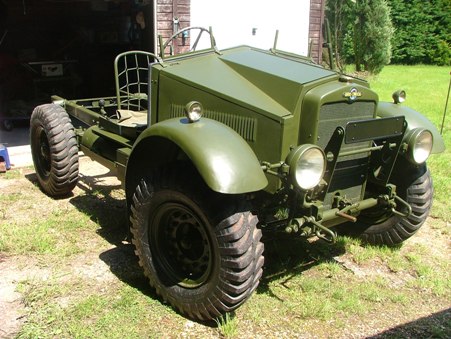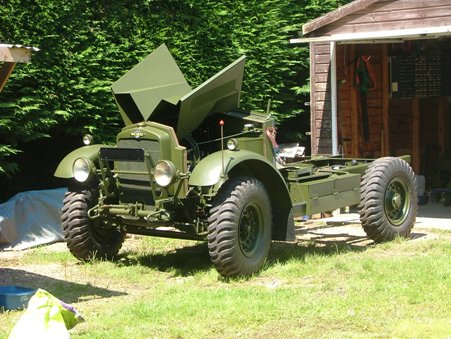"Gin Palaces"
Updated july 2012 with corrections
|
Morris Commercial CS8 Wireless
House bodies "Gin Palaces" Updated july 2012 with corrections |
|
Of the 26000 Morris Commercial CS8 trucks produced there are probably only 100 trucks
surviving .
These are mostly GS and Compressor types. Only a small number of other body types
have survived.
Water tanker, petrol tanker, office bodies and wireless bodies are all very
scarce.
The
Morris Commercial
CS8 and later C4
Wireless trucks had the Number one
Wireless Telegraph
house body fitted.
This came in three main types - the MK1, MK2 and MK3. Some examples are shown
below.
|
|
|
|
|
CS8 with early MK2 body and Aerial Roof No2
fitted |
CS8 with late MK2 body and Aerial Roof No5 fitted |
Later Morris Commercial
C4 with |
I am a little uncertain of the exact dates of Wireless body manufacture but it goes something like this:
MK1 = c1937 Prototype plus maybe one or two hundred production models.
Constructed
of wood with Aerial Roof No2 fitted.
(Prototype exist today)
MK2 = c1938 The MK2 body is slightly larger than the MK1, also made of wood with
the same Aerial Roof No2.
The MK2 was later produced with Aerial Roof No5. (At least 1 of this body type
exist today)
MK3 = c1942 metal clad over wood frame, different
window arrangement,
Vertical whip only fitted to roof.
This style of body was produced into the 1950's and fitted to other makes of truck,
At least 10 of this body type exist today.
Below is my Morris commercial CS8
truck fitted with wireless house body Number 1 MK 2
Date of Manufacture : 1938
Engine : 3498cc 6 cylinder (60hp)
Gearbox : 4 speed 'crash' box
Fuel Tank Capacity : 2 x 11 gallon (220 miles at 10mpg)
Gross Weights : 2 1/2 tons unladen (3 ¼ laden)
Suspension : Leaf springs and Luvax shock absorbers all round
Brakes : Hydraulic drum brakes
This Morris Commercial CS8 was made in 1938 as a wireless truck. The
truck was designed for use by the Royal signals as a
communications HQ,
fitted with a generator driven via a PTO from the truck's gearbox. Wireless
equipment such as the pre war
wireless sets (WS) No 2 or 9 and later
during the war the WS12 & R107 may have been fitted. Fortunately my
wireless house
has many of the original fittings including the fixings for a
ship's type speaking tube used for speaking to the driver.
When manufactured, this vehicle had canvas doors and cab roof, with only
aero screens to protect the driver and passenger from the
weather. Late
CS8s and C4s had full wind screens and steel doors. The
wireless house is made in a similar way to a
railway carriage. Its
construction is wood; canvas is used to waterproof the roof.
My truck was in service with the Army until about 1955; It had WW2 Second
Army and early 50s Territorial Army formation signs on it.
When it was sold to its first
civilian owner he used it as a fruit pickers hut and later as a field repair
workshop, until about 1985.
What was left of the vehicle was then stored
until purchased for parts in 2008 with a second in similarly poor
condition.
The chassis axles and body were all that was left. The rear body
needed a full rebuild so restoration was not a simple task.
A replacement
engine, gearbox and many other parts have been found or made and I hope
to have finished the majority of this
restoration sometime in 2012.
Radio equipment I have a WS12 transmitter
and R107 receiver.
So the intention is to restore the inside of the truck to 1941/1942
period. Trucks with this equipment were used in pairs. An 'A' truck with a R107
receiver and WS12 transmitter and a 'B' truck with
a R107
receiver and remote control used to operate the WS12 in the 'A' truck at a
distances of up to several miles.
The 'A' truck is
useable as a stand alone station.
|
|
|
|
On the generator hatch is a WW2 2nd Army
formation sign it's
hard to be certain of this as the colour has faded. |
I have tried to keep as much of the original woodwork as
possible. |
|
|
|
|
After a little TLC |
The inside will be fitted out as It could have been in
1941 |
|
|
|
|
|
The body is now almost complete and the truck restoration is progressing slowly. |
After adding the engine and some other parts |
|
|
|
Engine : 3498cc 6 cylinder
60hp
|
|
|
|
|
|
|
|
Many new parts have
had to be made this is one of two new petrol tanks made from stainless steel. Casting small parts was easier than Not long after the tanks
were fitted |
Cast in sand using an open fire. |
|
|
 |
|
 |
It runs and drives. |
|